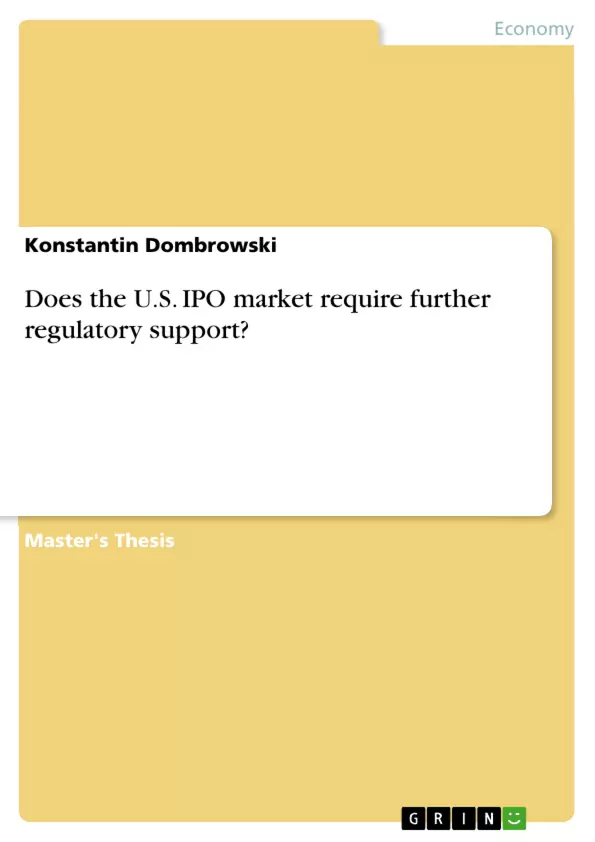This paper aims to divide the US financial markets into their three main components: the corporate sector, investment banking and institutional investors, represented by the asset management industry. This cross-disciplinary and holistic approach is based on an understanding of the IPO market as the intersection of these three main forces.
This paper seeks to broaden the current debate and extend the traditional issuer-underwriter-investor model beyond the immediate ecosystem of IPO markets. The main objective of this paper is to provide a comprehensive assessment of the key, systemic and underlying trends in these three underlying disciplines and to identify potential areas for regulatory action.
This paper finds academic evidence in the area of public equity offerings that regulatory initiatives can be effective and tilt the balance between private and public equity finance towards more regulated and transparent markets. It is also essential to acknowledge that this rebalancing was supported by financial innovation and it remains doubtful whether the JOBS Act can be as effective in the absence of similar innovation at the core of the IPO product, which remains locked between excessive underwriting fees and unresolved conflicts of interest in the analyst community, a key support function. These areas require further and immediate regulatory action to restore the competitiveness of the IPO product and to preserve the integrity of the IPO market as a whole.
Inhaltsverzeichnis (Table of Contents)
- 1. INTRODUCTION
- 2. CORPORATE SECTOR.
- 2.1. CORPORATE FINANCE
- 2.1.1. Valuation...
- 2.1.2. Innovation..
- 2.1.3. Diversification......
- 2.2. CORPORATE GOVERNANCE..
- 2.2.1. Board of directors.
- 2.2.2. CEOs pay.
- 2.2.3. Stock options...
- 3. INVESTMENT BANKING...
- 3.1. LENDING........
- 3.1.1. Syndicated loans..
- 3.1.2. Structured debt..
- 3.1.3. Corporate bonds.
- 3.2. UNDERWRITING.
- 3.2.1. Consolidation.......
- 3.2.2. Accelerated offerings..
- 3.2.3. Analyst research.
- 3.3. TRADING...
- 3.3.1. Liquidity.
- 3.3.2. Dark pools.
- 3.3.3. High-frequency trading...
- 4. ASSET MANAGEMENT..
- 4.1. MAINSTREAM STRATEGIES..
- 4.1.1. Institutional investors
- 4.1.2. Foreign investors
- 4.1.3. Passive investors..
- 4.2. ALTERNATIVE STRATEGIES.
- 4.2.1. Private equity..
- 4.2.2. Hedge funds.
- 4.2.3. Insider trading..
Zielsetzung und Themenschwerpunkte (Objectives and Key Themes)
This paper aims to provide a comprehensive assessment of the trends in the U.S. financial markets, specifically focusing on the corporate sector, investment banking, and asset management industries. It explores the dynamics of the initial public offering (IPO) market as an intersection of these forces and seeks to identify potential areas for regulatory action.
- The decline in IPO activity, particularly among small companies, and the reasons behind it.
- The impact of regulatory initiatives like the JOBS Act on the IPO market.
- The role of financial innovation and its influence on the IPO landscape.
- The trade-offs between the costs and benefits of going public for small companies.
- The impact of regulations such as Sarbanes-Oxley (SOX) Act on IPO activity.
Zusammenfassung der Kapitel (Chapter Summaries)
- Chapter 1: Introduction: This chapter introduces the declining number of listed companies in the U.S. since 1996 and the low rate of new listings as a significant factor. It highlights the regulatory response in the form of the JOBS Act and its inconclusive impact, leading to the research question of whether further regulatory support is needed for the U.S. IPO market. The paper adopts a cross-disciplinary approach, examining the corporate sector, investment banking, and asset management industries.
- Chapter 2: Corporate Sector: This chapter delves into the corporate sector, exploring areas such as corporate finance (valuation, innovation, diversification) and corporate governance (board of directors, CEO pay, stock options). This section provides insights into the internal workings of companies and their financial strategies.
- Chapter 3: Investment Banking: This chapter focuses on the investment banking industry, examining its role in lending (syndicated loans, structured debt, corporate bonds) and underwriting (consolidation, accelerated offerings, analyst research). This section investigates the processes of raising capital and facilitating IPOs.
- Chapter 4: Asset Management: This chapter delves into the asset management industry, covering mainstream strategies (institutional investors, foreign investors, passive investors) and alternative strategies (private equity, hedge funds, insider trading). This section explores the investment perspectives of different types of market players.
Schlüsselwörter (Keywords)
This study focuses on the U.S. IPO market, examining its dynamics and exploring regulatory challenges. Key areas of interest include corporate finance, corporate governance, investment banking, asset management, regulatory initiatives, financial innovation, and the impact of regulations like the JOBS Act and the Sarbanes-Oxley Act.
- Quote paper
- Konstantin Dombrowski (Author), 2018, Does the U.S. IPO market require further regulatory support?, Munich, GRIN Verlag, https://www.grin.com/document/1446291



